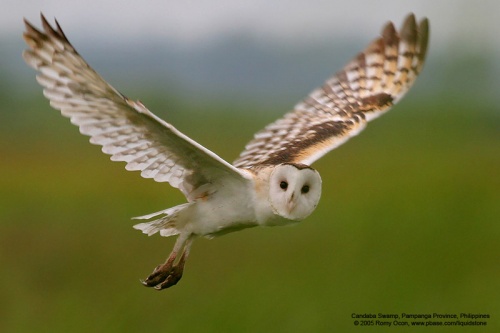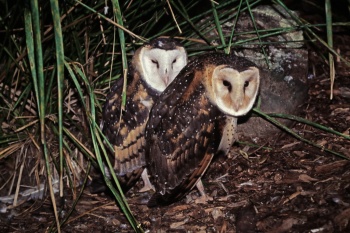Alternative names: Australasian Grass-Owl; Australian Grass-Owl
- Tyto longimembris
Identification
Male: 32-36cm (12½-14¼ in); Female: 35-38cm (13¾-15 in)
- above dark brown, pale spots
- below cream or buff with brown spots
- wing bars buff
- facial disc white
- mark in front of each eye brown
- iris brown
- bill pale brown
- legs very long, feathered
- feet grey
Distribution
India to southeast Asia, Philippines, and Australia.
Taxonomy
Until recently, the Eastern Grass Owl was considered to be conspecific with African Grass Owl as "Grass Owl". Reference [4] notes that the morphological and genetic differences between these species are minor.
Subspecies
Clements recognises the following subspecies [1]:
- T. l. longimembris: India to Indochina, Sulawesi, Lesser Sundas, northern and eastern Australia
- T. l. chinensis: South-eastern China (south-eastern Yunnan to Jiangsu) and Vietnam
- T. l. pithecops: Taiwan
- T. l. amauronota: Philippine Islands
- T. l. papuensis: West central New Guinea (Baliem Valley), and eastern New Guinea (highlands of the Eastern Range, Huon Penins, Huon Peninsula, and Southeastern Peninsula)
Habitat
Grasslands, canefields and paddy Fields.
Behaviour
Nocturnal.
Diet
Their diet consists almost entirely of rodents.
Breeding
They are ground-nesters, building the platform nest from grass in dense tussocks of grass or sedges. The 3-8 dull white eggs are incubated for about 42 days. The young fledge at about 2 months.
References
- Clements, J. F., T. S. Schulenberg, M. J. Iliff, S. M. Billerman, T. A. Fredericks, J. A. Gerbracht, D. Lepage, B. L. Sullivan, and C. L. Wood. 2021. The eBird/Clements checklist of Birds of the World: v2021. Downloaded from https://www.birds.cornell.edu/clementschecklist/download/
- Owlpages
- Handbook of the Birds of the World Alive (retrieved Nov 2017)
- Eaton, JA, B van Balen, NW Brickle, FE Rheindt 2021. Birds of the Indonesian Archipelago (Greater Sundas and Wallacea), Second Edition. Lynx Editions. ISBN978-84-16728-44-2
Recommended Citation
- BirdForum Opus contributors. (2024) Eastern Grass Owl. In: BirdForum, the forum for wild birds and birding. Retrieved 28 April 2024 from https://www.birdforum.net/opus/Eastern_Grass_Owl
External Links
GSearch checked for 2020 platform.1





